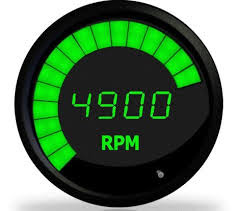In motor vehicle applications , tachometers installation in order for the rider to use the machine efficiently.
History .
Estimated mechanical tachometers was first made by a German engineer , Diedrich Uhlhorn in 1817 to measure the speed of rotation of the crankshaft . Since 1840, tachometers began to be used as an indicator of the speed of the locomotive.Tachometer is an instrument used to measure the rotation speed of the shaft ankle / disc motors or other machinery . There are three functions that can be selected on / switch tachometer / , ie rpm ( / resolution per minute / ) to calculate the distance traveled .
The working principle of this instrument is of the input data is a modified round by the sensor as a frequency value of the frequency then inserted in series / frequency to voltage converter / ( F to V ) outputs a voltage , is used to move the needle on an analog or incorporated tachnometer ( / analog to digital converter ) / ADC in a digital tachometer to be converted into digital data and is shown on the display .
Various tachometer .
Optical tachometer .
Optical tachometer is an instrument for measuring the angular velocity of the play with the amount of rpm . Optical tachometer consists of lines or line ( stripe ) contained in the trunk then there is a photosensor or facing on the trunk .How it works every rod that rotates the photosensor will detect the amount stripe through it . Will then generate output that will be shaped pulses . In the pulse wave period â ‰ opposite of angular velocity . Can be measured using a counter circuit as depicted in the trunk optical encoder . The advantages of optical tachometer has a photosensor that is able to detect any line through it , while the disadvantages can not sense the position and distance , but it can be treated using 2 pieces photosensor .
Scalloped Rotor Tachometer .
Sensor consists of a fixed and a player serrations , wheels , and iron materials . There are two types of sensors are used :
Variable reluctance sensor.
Hall Effect Sensor . There is a magnet that hangs as a sensorThe way it works is the spinning rotor, then the rotor toothed part to be measured.
A magnetic sensor that will detect any such serrations are passed . Each serration through the magnetic field increases and induces a voltage in the winding wire that will be produced pulse . Pulse is converted into a clean square wave with a threshold detector circuit . The advantages of these serrations tachometer is Giving a pulse every time when iron teeth through it and generates a pulse signal box clear.
DC tachometer .
DC tachometer is a DC generator which produces a DC output voltage that is proportional to the speed of the rod . Consisting of permanent magnets and rotating parts made of coils , as well as direct conversion occurs .Its working principle is the direct conversion process between speed and voltage . Tachometer is what is used in marine instrumentation lab in this opportunity . The advantages of this DC tachometer is to keep down the inertia can be overcome with the use of a brush while its own drawbacks , namely the use of a brush to keep the inertia can be worn .
Touch Tachometer / Tachometer Paste .
In this type of sensor on the tool requires touching the objects being measured . In its application of this type tachometer rarely used in certain areas with the technical or safety reasons .Tachometer Laser / Photo Tachometer .
In this type makes it possible to perform measurements of distance . Laser Tachometer work with light sensor is very sensitive to the rotating element . Rotating element will have a reflective place , and rpm meter measures the rate at which the light beam is reflected back .Use of Tachometer .
Use in Cars .
In the most widely used form , where the tachometer to measure the speed of a rotating mechanical device , which is usually indicated in RPM . Used to monitor RPM tachometer in the car because it runs the engine RPM is too high a price can drastically reduce the life of the machine becomes shorter .There are several ways in which the tachometer should be used can be built . In some cases , a small generator attached to the engine drive shaft , and RPM measurements are based on the electrical current generated by the device . It may also just measure the rate at which the ignition system sends sparks into the engine.
In the use of aircraft .
Laser Tachometer .
Tachometer in the past require physical contact between the instrument and the measured objects . In applications where this is not feasible for technical or safety reasons , it is possible for the laser to take measurements remotely . Laser Tachometer work with pulsed beam of light tight against the rotating element . Rotating element will have a reflective place , and a tachometer to measure the rate at which the light beam is reflected back . Laser Tachometer can become a permanent part of the system , or they can be hand-held for occasional point measurement .In Medical Uses .
Tachometer can even find a use in medicine . By placing a small , turbine - like instrument called haematachometer in an artery or vein , a doctor can use a tachometer to infer the rate of blood flow from the speed at which the turbine rotates. It can be used to diagnose circulatory problems such as clogged arteries.So , thank you for reading this article. Written and posted by Bambang Sunarno.
sunarnobambang86@gmail.com
author :
http://schema.org/Personal.
https://plus.google.com/105319704331231770941.
name : bambang sunarno.
http://primadonablog.blogspot.com/2014/03/did-you-know-about-tachometers.html
DatePublished : March 28, 2014 at 18.10
Tag : Did You Know About tachometers.





No comments:
Post a Comment